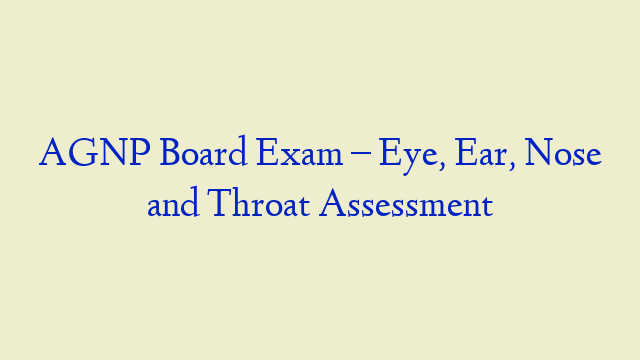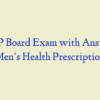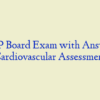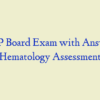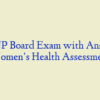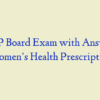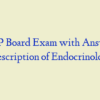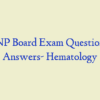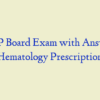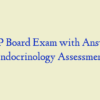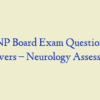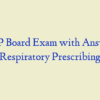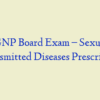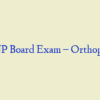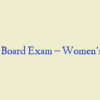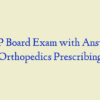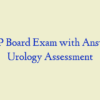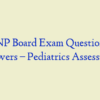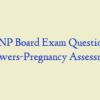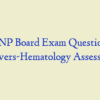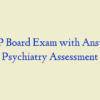Description
AGNP BOARD EXAM QUESTIONS Assessment Eye, Ear, Nose and Throat (166 Questions)
- Ophthalmoscopic examination of the fundus reveals small, rounded, slightly irregular red spots embedded in the retina. These findings are consistent with:
- The whispered voice test allows the examiner to screen for:
- On examination of the tympanic membrane, a red bulging ear drum is detected. This is consistent with:
- One of the refractive errors of vision that presents with symptoms of blurriness and improved with corrective lens, is known as:
- Miosis is a term used to describe:Otosclerosis is an example of a(n):
- Drooping of the upper eyelid is termed:
- When a light beam shines into one pupil causing pupillary constriction in that eye, the term used is:
- Where in the mouth would reddened areas, nodules, or ulcerations that are suspicious of malignancy be present?
- An example of a cause of conductive hearing loss in children would be:
- A man with a history of long-term use of chewing tobacco presents with a mouth lesion that is suspicious for malignancy. Oral assessment findings describe:
- Mydriasis is a term used to describe:
- Ophthalmoscopic examination of the retina reveals AV tapering. This appears as if the:
- Causes of sensorineural hearing loss include all of the following except:
- All of the following diseases may be associated with the appearance of a strawberry tongue except:
- Janeway lesions of the palms and soles appear as:
- Which of the following screening tests for hearing loss can detect both sensorineural and conductive hearing loss?
- Examination of the nose and paranasal sinuses reveal local tenderness, pain, fever, and rhinorrhea. These symptoms are suggestive of:
- The mouth of a ten-month-old infant has white patches on the mucosa that cannot be removed. These patches are consistent with:
- In patients who have allergic rhinitis, the nasal mucosa appears:
- Assessment of a 4 year-olds visual acuity resulted in 20/30 in the left eye and 20/40 in the right eye using the Snellen eye chart. This means:
- Round or oval shaped lesions surrounded by erythematous mucosa and noted on an area of the oral mucosa may be:
- A deviated trachea could be caused by all of the following except:
- When examining the conjunctiva and sclera, have the patient look upward and then:
- A sixty-year-old complains of a progressive bilateral hearing loss over the past four months. He has difficulty understanding spoken words and has become sensitive to loud noises. These symptoms are consistent with:
- In order to visualize the opening of Stensen’s duct, examine the:
- A condition that involves optic nerve damage and visual field changes is termed:
- Sudden bilateral and painless visual loss is rare but can be associated with all the following except:
- When examining pupillary equality, the left pupil is slightly greater than the right pupil. This condition is termed:
- Redness, bleeding, pain, and swelling of the gums is most likely: (AGNP BOARD EXAM QUESTIONS Assessment)
- A condition of the sclera that appears as localized ocular inflammation of the episcleral vessels is most likely:
- When a 512 Hz tuning fork is placed over the mastoid bone and then held next to the ear canal with recordings of how long sound was heard in each ear, this is known as the:
- A patient complains of seeing specks that obscure his line of vision when he looks in a certain direction. This impairment could be caused by:
- Current indications for tympanostomy tube placement include all of the following except which one?
- On examination of the pupils, both are round but the right pupil appears larger than the left and reacts much slower to light. This condition may be indicative of:
- Findings following assessment of a person’s gaze include the inability of the left eye to look down when turned inward. This condition is most consistent with:
- The acronym for pupils that are equal, round, react to light and accommodate is:
- On otoscopic examination, the cone of light can be visualized:
- The function of the auditory ossicles is to:
- On the outer ear, anterior and parallel to the helix, is a curved prominence known as the:
- A patient was diagnosed as nearsighted. The term for this condition is:
- The sphenoidal sinuses:
- Fordyce spots or granules are considered:
- The gradual loss of vision with a change in color and size of the optic disc is referred to as:
- The nasolacrimal duct drains into the:
- Examination of the eye reveals a painful, erythematous, and tender area around the nose and lower eyelid. This condition is most likely:
- During the newborn’s physical assessment of the mouth, the soft and hard palates are palpated to detect:
- That portion of the ear that consists of the auricle and ear canal is the:
- Which of the following findings in a preschooler would indicate the need for further evaluation?
- A 45-year-old patient complains of vertigo, tinnitus and pressure in the right ear. These symptoms are consistent with:
- A patient was diagnosed as being farsighted. The term for this condition is:
- A 60-year-old was concerned about a yellowish colored lesion above her right eyelid. Findings revealed a slightly raised yellowish, well circumscribed plaque along the nasal area of her right eyelid. This finding is most consistent with:
- The lacrimal puncta are located:
- The patient complains of seeing floating spots. This is consistent with:
- A cyclist sustained an avulsion of the upper central incisor. If he is unable to position the tooth in the socket until he is able to be seen by a dentist, he should: (AGNP BOARD EXAM QUESTIONS Assessment)
- Surgical perforation of the tympanic membrane to allow drainage of middle ear secretions is termed:
- On ophthalmoscopic examination, optic atrophy appears:
- The usual position of the trachea is located:
- A patient is able to read a magazine without difficulty but cannot distinguish distant objects. This describes:
- Eversion of the upper eyelid can be performed by placing the cotton applicator on the upper lid above the level of the internal tarsal plates and then:
- When inspecting the neck for the thyroid gland, slightly tilt the patient’s head back, and using tangential lighting directed downward from the tip of the patient’s chin, inspect the:
- The conductive and sensorineural phases are necessary for hearing to take place.
- The conductive phase of hearing involves the:
- On ophthalmoscopic examination, glaucomatous cupping appears:
- When the corneal reflex is stimulated by shining the light in the right eye, the right eye blinks. The left eye:
- An inward turning of the lower lid margin is called:
- Which of the paranasal sinuses are accessible to clinical examination?
- If a patient has a history of heat intolerance with a preference to light clothing, this behavior could be consistent with:
- When examining the eyes, the right pupil reacts briskly to light, near effort, and is much smaller than the left pupil. This condition is mostly likely:
- The most common cause of bacterial pharyngeal infections in children is:
- One of the main differences between a migraine headache and a tension headache is that:
- Ophthalmoscopic examination of the fundus reveals blood anterior to the retina and obscuring retinal vessels. These findings are consistent with:
- The most common disorder of visual acuity in children is:
- A teenage complains of itching and burning of his eye. Examination reveals an erythematous eyelid margin with crusting and a clear mucus discharge. These findings are consistent with:
- What visual acuity constitutes legal blindness?
- Examples of sudden, painful, unilateral visual loss include all the following except:
- The function of the labyrinth in the inner ear is to:
- A 40-year-old male was umpiring a little league baseball game when he was hit in the face with flying debris. He presents with decreased vision and severe pain in the left eye. Findings reveal watery, left ocular discharge. The pupils are normal in appearance and the cornea is slightly cloudy with areas of corneal erythema. These findings are most consistent with:
- Children who pick their noses are at a higher risk for development of:
- A deviated uvula without swelling may be suggestive of a:
- The maxillary sinuses:
- What part of the ear consists mainly of cartilage covered by skin and has a firm yet somewhat elastic feature?
- When examining the pupils, the left pupil is noted to be fixed and dilated to light and near accommodation. This condition may be suggestive of:
- A term used to describe drainage from the nose is:
- The curved outer ridge of the auricle of the ear is known as the:
- Eyelid retraction with exophthalmos presents as:
- A patient presents with complaints of earache, blood tinged discharge from the ear, and hearing loss. Findings reveal painful hemorrhagic vesicles on the tympanic membrane and the ear canal. These findings and symptoms are suggestive of:
- One cause of nasal septum perforation may be:
- Which disorder of the eye can be detected with the cover-uncover and the Hirschberg test?
- A patient presents with complaints of a bump on the eyelid. Findings reveal nontender, firm nodule with freely movable skin overlying the nodule. This could be consistent with:
- A 50- year-old patient complains of being unable to read the hymnal at church. This describes:
- A swollen deviated uvula may be associated with a:
- Ophthalmoscopic examination of the retina reveals AV banking. This appears as if the:
- Findings following assessment of a person’s eye gaze include both eyes moving in the same direction simultaneously. This condition is most consistent with:
- A forty-five-year-old female complains of frequent attacks of dizziness accompanied by a sense of fullness in the right ear, headache, nausea, reduced hearing in the right ear. This patient may need further workup for:
- When comparing veins and arteries in the eyes of older adults, the arteries appear:
- An infant with a suspected hearing loss:
- A condition in which the eyes are not properly aligned with each other is termed:
- In the normal ear, all of the following landmarks can be visualized when using the otoscope, except the:
- Leukoplakia was noted during an exam of the mouth. This symptom may be:
- A granulomatous eyelid cyst or nodule that is painless and erythematous is termed:
- A fine rhythmic oscillation of the eyes is termed:
- Symptoms of bacterial conjunctivitis in an infant include:
- A 30-year-old patient presents with a moderate “aching” in his right eye. Findings reveal a small and irregular shaped right pupil. The cornea appears cloudy with a slight erythematous area around the corneal limbus. There is no ocular discharge noted. These findings are consistent with:
- The middle ear consists of:
- A 35-year-old patient complains of vertigo accompanied by nausea and vomiting. Examination reveals bilateral diplopia and an unsteady gait. These symptoms could be suggestive of:
- A softening of the skin at the angles of the mouth which may be due to nutritional deficiency is commonly referred to as:
- All of the following are examples of causes of sensorineural hearing loss in children except:
- Ophthalmoscopic examination of a 30-year-old with a history of an eye injury 3 years ago, reveals a superficial grayish-white opacity in the right cornea.
- This may be indicative of a:
- With transillumination of the maxillary sinuses, a reddish glow is observed on the hard palate. This red glow would be indicative of:
- Actinic cheilitis is a condition of the lower lip most commonly seen in:111. A 4-year-old child presents with bilateral watery discharge from the eyes. Examination reveals subconjunctival hemorrhage, and eyelid ecchymosis. These findings are consistent with: (AGNP BOARD EXAM QUESTIONS Assessment)
- A patient complains of a sore tongue. Findings reveal a smooth and erythematous tongue. This condition is termed:
- On physical exam, an abnormal Rinne test might indicate:
- The fleshly projection of the earlobe is know as the:
- Examination of the nasolacrimal duct reveals a mucopurulent discharge from the puncta. This finding is suggestive of:
- To palpate for frontal sinus tenderness, press up on the frontal sinuses from under the bony brows, then:
- A nodular protuberance that points backward over the entrance to the ear canal is call the:
- A 60- year-old patient presents with severe, deep left eye pain. Findings reveal dilate and fix left pupil and the cornea is cloudy.
- There is no ocular discharge note. These findings are most likely consistent with:
- A patient presents with findings of pain, warmth, redness, and swelling below the inner canthus toward nose. Tearing is present and when pressure is applied to the lacrimal sac, purulent discharge from the puncta is note. This is suggestive of:
- When assessing extraocular movements:
- Ptosis is define as:
- When a person shifts gaze from a near object to a far object, the pupils:
- Assessment of a patient’s visual acuity resulted in 20/200 using the Snellen eye chart. This means that:
- A 57-year-old man with a history of diabetes complains of difficulty hearing on the telephone and muffled sounds while watching the television at a low volume. He should be further evaluated for:
- Ophthalmoscopic examination reveals dark specks noted between the fundus and the lens. These specks are most likely:
- What connects the middle ear to the nasopharynx? agnp board exam
- Upon examination of the right tympanic membrane, a cone of light was visible at the four o’clock mark. This would be interpret as:
- When examining the eyes, both pupils appear small and have an irregular shape. They are note to accommodate but do not appear to react to light. This could be indicative of: (AGNP BOARD EXAM QUESTIONS Assessment)
- Ectropion is define as:
- Gingival hyperplasia could be seen in all the follow conditions except:
- A 30-year-old patient presents with complaints of seeing double in the right eye. Examination reveals diplopia in the right eye when the left eye is close. This may be suggestive of a:
- A deposit of uric acid crystals appearing as hard nodules on the helix or antihelix is term:
- A patient presents with complaints of burning, itching, tearing, and some pain in the eye. Findings reveal red, scaly, greasy flakes and thickened, crust lid margins. This would be suggestive of:
- An eight-year-old complains of itching in the right ear and an increase in pain when the pinna is pulled or the tragus is palpate. Examination reveals slight redness in the ear canal with a clear odorless fluid. This could be suggestive of:
- If there is an abnormal protrusion, what condition should be suspect if there is an abnormal protrusion of the eyes?
- Sudden visual loss suggests:
- A six-year-old child presents with sore throat, difficulty swallowing, and a temperature of 102 °F. Findings reveal lymphadenopathy and pharyngeal erythema. This is probably:
- A toddler with a suspected hearing loss would: (AGNP BOARD EXAM QUESTIONS Assessment)139. A reduction in vision in one or both eyes causing loss of binocular vision is termed:
- The Rinne hearing test allows the examiner to screen for:
- A patient is able to recognize distant objects but has difficulty reading a book’s small print. This describes:
- On ophthalmoscopic exam of the older adult, there is an increased cup-to-disc ratio: This finding is suggestive of:
- The majority of people who present with non-24 hour sleep-wake disorder are:
- A person who has been blind since birth presents for a physical exam. Expect findings of the pupillary reaction when light is shown would be:
- A localized Staphylococcal infection of the hair follicles at the lid margin is suggestive of:
- Ophthalmoscopic examination of the fundus reveals tiny, round, red spots in and around the macular area. These findings are consistent with:
- When administering ear drops to a 6-year-old, the pinna should be pulled:
- Sudden bilateral and painful visual loss is rare but can be associated with:
- Performance of the Weber and Rinne tests to assess for hearing loss is best performe using tuning fork with a frequency of:
- To visualize the ear canal and the tympanic membrane of an adult, use the otoscope with:
- A six-year-old complains that something is in her left eye. There is a red raise area of the left lid. There is redness and tenderness of the eye and tearing. These findings are consistent with:
- A 40-year-old patient presents with complaints of seeing double bilaterally. Examination reveals a horizontal diplopia.This may be suggestive of a:
- The ethmoidal sinuses:
- The ossicles are locate in the: (AGNP BOARD EXAM QUESTIONS Assessment)
- A 50-year-old patient presents with complaints of seeing double bilaterally. Examination reveals a vertical diplopia. This may be suggestive of a:
- If a patient complains of seeing flashing lights across the field of vision, this could be:
- A buildup of excess fluid around the periphery of the eye orbits is known as:
- A child presents with a complaint of a left earache that worsens with head movement. Findings on examination include temperature of 102 °F, cellulitis behind the left ear. These findings are consistent with:
- On ophthalmoscopic examination of a 70-year-old, a thin grayish-white arc is noted on the lower end of the cornea. This appearance is refer to as a:
- Ophthalmoscopic examination of the retina reveals a normal arteriovenous crossing. This appears as if the:
- In order to examine the tongue, ask the patient to stick out his tongue and with the examiner’s right hand:
- Most of the paranasal sinuses drain into the:
- Raised or flat, deep purple colored lesions note in the mouth may be suggestive of:
- Findings following assessment of a person’s left eye gaze include impaire movements when attempting to look upward, downward, or inward. This condition is most consistent with: (AGNP BOARD EXAM QUESTIONS Assessment)
- With transillumination of the frontal sinuses, a dim red glow is observe on the forehead. This dim red glow would be indicative of:
- All of the following symptoms in a 10-month-old would be indicative of acute otitis media (OM)except:
